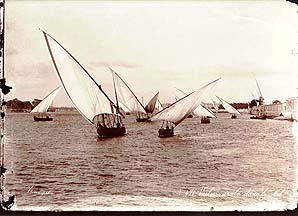Voiliers arabes dans le Nil, by Zangaki

Bibliog. 'Souvenir of Egypt: Monuments, Temples, Mosques, and Scenes from Every-day Life (Cairo, George Ch. Dovas: 1898), plate 44 'Boats on the Nile' (version not signed) With the annual fluctuations in the level of the Nile due to the inundation, the prime sailing time for large vessels was--before the construction of the High Dam at Aswan--limited to the six months between July and December. For this reason, a year-round use of small boats was often preferred. Even during the reign of Ramesses II, the fleet that carried sandstone blocks from the quarries of Gebel Silsileh (near Kom Ombo) to Thebes for the construction of the Ramesseum, the king's mortuary temple, consisted of small craft, each of which carried only 5 to 7 blocks, about 15 tons. Attested already in antiquity, the triangular lateen sail was to become during Byzantine times and the early Middle Ages the most important sail of the Mediterranean world. The tall, narrow lateen--perhaps derived from a braided-up square sail with a slanted yard for sailing close-hauled in a hard wind--is well suited to catching the breezes skimming above the Nile between the looming desert escarpments. Signed at lower left "Zangaki"; Caption at lower right "Nr. 411 Voiliers arabe [sic.] dans le Nil".
- Wet collodion on glass
- 23.5 x 29.5 cm
- $535.00

